The Aichi Environmental Conservation Strategy -Towards Preserving Biodiversity and Sustainable Use
Our lives and our lifestyles rely upon biodiversity—having a diverse natural environment and an abundance of life.
It is from a rich natural environment that we obtain the rice and vegetables we eat, seafood, wood for building homes, and wool and silk for making clothing; and in addition to shielding us from disaster, nature enriches our spirits with its peacefulness and its powers of healing.
We want Aichi Prefecture to be a society that preserves the gift of biodiversity, uses the bounty of nature in a sustainable fashion through various industrial activities, and truly appreciates just how much we benefit from it.
1. About the Aichi Environmental Conservation Strategy
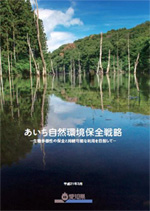
March, 2009
Target Date2025
ObjectiveWe want to achieve a symbiotic relationship between humans and nature through the creation of communities that support rich and abundant biodiversity.
2. The Future of Our Land
Encourage biodiversity, i.e. “a diverse natural environment and abundance of life.”
(2) Making Use of Biodiversity in a Sustainable FashionShare the benefits of biodiversity with future generations.
(3) Making a Comprehensive Effort Through Cooperation on Many FrontsMake a comprehensive effort through cooperation on many fronts so that the symbiotic relationship between man and nature becomes instilled in our culture.
3. Fundamental Approaches
- (1) Take a comprehensive approach: promote efforts that take into account both global warming concerns and resource recycling.
- (2) Take an ecosystems approach: act flexibly and preventatively, rooted in a scientific understanding of ecological systems.
- (3) Encourage widespread participation and cooperation: build a network of residents, businessmen, non-profit organizations, and specialists that can collaborate on many fronts.
- (4) Take action with a long-term perspective: keep up activities that require long-term commitment in order to effect environmental restoration.
- (5) Take action with a regional and international perspective: engage in broad international activities that relate to the hydrological cycle and resource recycling.
4. Action Plans
(1) Preserve biodiversity.
Biodiversity will be preserved by ensuring diversity at three levels: ecosystems, species, and genetics.
To that end, we aim to preserve the flora, fauna, and ecosystems that form natural environments such as forests, greenbelts, rivers, and wetlands by developing ecological networks and maintaining a healthy hydrologic cycle.
It is also important that we protect rare plant and animals in order to prevent the extinction of the species that exist today.
Work to preserve and restore the managed ecosystems of the rural countryside, mountainside, and coastal communities that have formed through the union of man and nature over the centuries, and create new such communities. Preserve the unique character of each community; and at the same time, construct networks between the residents of these communities that are managed properly and utilized effectively.
- Thin out artificial woods created through Aichi forest and greenbelt taxes. Preserve and make use of satoyama (managed forests).
- Preserve diverse environments like rice paddies—for example, by adding “paddy fishways” that can improve the biodiversity of rice paddies.
- Preserve tidal flats and coastal seaweed beds.
Link diverse natural environments—like water reservoirs and forests—with green zones and shorelines to create water and forest linkages that span from distant mountains to the sea, and in so doing develop “ecological networks” that wild plant and animals species can travel across.
- Designate and preserve new nature conservation areas
- Develop a core area network of nature conservation areas.
- Support the efforts of NPOs using Aichi forest and greenbelt taxes.
- The “Life-Sustaining Forest Development Campaign”
Make efforts toward understanding and protecting endangered species; dealing with notable species that threaten agriculture, forestry, and fishing, such as wild boar; and lessening the impact of invasive species on our ecosystems.
- Develop a system for designating and capturing rare plants and animals.
- Come up with a plan for not only protecting birds and animals that have a negative impact on agriculture but also mitigating the damage they do.
- Publically identify alien species that are likely to cause significant harm to ecosystems and educate the public to prevent the introduction and cultivation of these species.
(2) Make use of biodiversity in a sustainable manner.
Our modern lifestyle and industrial activities are heavily dependent and reliant upon natural resources. Thus, our goals are to show consideration for biodiversity in all industrial activities, including agriculture, forestry, and fishing as well as manufacturing; to make sure that future generations may continue using these resources; and to make Aichi a comfortable and pleasant place to live.
■Finding Harmony Between Local Development and BiodiversityDevise a plan for achieving harmony between local development and the preservation of biodiversity by taking early preventative action against activities that impact the environment and dealing with ecological change in a flexible manner, and by introducing an ecosystems approach in order to understand how symbiosis between people and the environment can work.
■Consideration for Biodiversity in IndustryPromote industrial guidelines that encourage businesses to voluntarily show consideration toward biodiversity in both natural resource procurement and production processes.
■Using Biological Resources in IndustryTackle environmental issues such as global warming and resource recycling by encouraging the development of technologies and industries that use environmentally-friendly biological resources like biomass.
■Demonstrating Biodiversity Conservation in Agriculture, Forestry, and FishingWork to ensure that future generations may continue to use our natural resources by developing sustainable agriculture, forestry, and fishing industries.
- Promote the development of diverse forests.
- Maintain and improve coastal seaweed beds and tidal flats.
- Maintain and improve the versatility of water reservoirs.
- Promote environmentally friendly agriculture through Eco-Farmer certification.
- Develop environmentally-friendly techniques such as no-tilling farming.
(3) Make a comprehensive effort through cooperation between key participants.
We want to build a foundation for the sustainable use and conservation of biodiversity, a foundation that will instill and establish the importance of biodiversity in society by promoting environmental studies, by changing lifestyles, and by promoting efforts to conserve the environment and protect wild flora and fauna. To do this will involve cooperation and collaboration of residents, businesses, NPOs and NGOs, specialists, and government administrations in all communities throughout Aichi, all with their own roles to play.
■Raising the Awareness of ResidentsPromote awareness and education and engage in collaborative efforts so that all participants can get involved in preserving and restoring biodiversity, whatever their respective roles may be.
■Full Participation and CooperationPromote voluntary conservation activities and social action programs by businesses. Use the Aichi forest and greenbelt tax to preserve and restore ecosystems.
- Support voluntary efforts by NPOs using the Aichi forest and greenbelt tax.
- Promote social action programs such as “Commercial Forest Development.”
- Promote the “Hydrologic Cycle Restoration Initiative,” in which residents can participate by diagnosing the health of rivers.
In order to preserve biodiversity, promote the creation of networks and systems for the advancement of ongoing research into the natural environment and wild flora and fauna, and for the collection and sharing of related data.
- Conduct regular reviews of the Red Data Book.
- Analyze the presence and growth of introduced species.
Protecting Nature, Coexisting with Nature
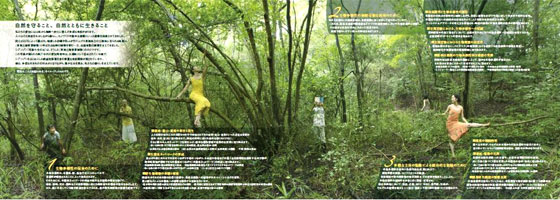
The nature of Aichi, from the mountains to the seashore, is diverse and rich in variety.
Living in the midst of that nature, people have developed industries: manufacturing, agriculture, forestry, and fishing.
For example, rivers carry and deposit clay and gravel throughout the highlands of the Tokai region, resulting in soil that not only supports unique flora known as “Tokai highland vegetation,” but has also made it possible for the country’s foremost ceramics industry to develop here.
One example of Tokai highland vegetation is the shidekobushi, or star magnolia (the tree in the center of the photograph).
The prefectural forest in Seto, shown in this photograph, is a forest protected as a water reservoir, and it harbors a precious natural environment that includes endangered species such as the star magnolia. While this forest provides a home for many different living creatures, it is also a plentiful source of water on which we rely for our own lives.
Ecosystem Conservation
The term ecosystem refers to “the totality of a natural environment that includes living organisms as well the water, air, and soil surrounding them.” The accompanying photographs show six ecosystems that are representative of Aichi Prefecture. Each ecosystem supports its own diverse array of life. The entire environment on which living organisms rely, whether woodland, shoreline, or any other environment, needs to be preserved.
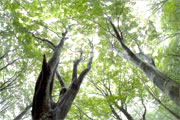 Mountain Ecosystem (Shitara)
Mountain Ecosystem (Shitara)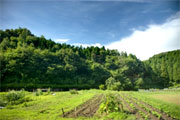 Managed Woodland Ecosystem (Seto)
Managed Woodland Ecosystem (Seto)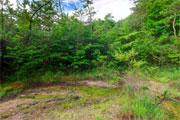 Marsh and Wetland Ecosystem (Seto)
Marsh and Wetland Ecosystem (Seto)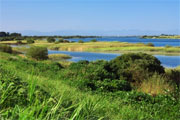 River and Lake Ecosystem (Aisai)
River and Lake Ecosystem (Aisai)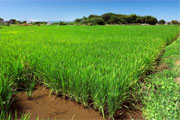 Plains Ecosystem (Ichinomiya)
Plains Ecosystem (Ichinomiya)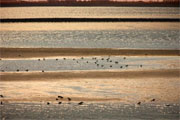 Seashore and Managed Coastal Ecosystem (Nagoya)
Seashore and Managed Coastal Ecosystem (Nagoya)
Developing Ecological Networks

Connect areas with exceptional natural environments (core areas) using the greenbelts along rivers, roads, and parks as corridors, creating an ecological network which preserves the vital zones and linkages that living creatures need for living space and growth.
Japanese website: https://www.pref.aichi.jp/soshiki/shizen/0000028443.html








